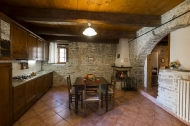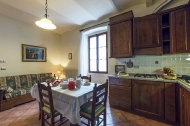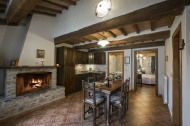Monte Acuto
Umbertide (Perugia) Code
Profile
In brief
- Type: Flat (4),
- Guests: 21
- Map: Hills
- Type of accommodation: Room only
The agriturismo
Offering an outdoor pool and a children's playground, Agriturismo Monte Acuto offers accommodation on an organic farm specializing in cereals and olive oil. WiFi is free in all areas. The center of Umbertide is a 10-minute drive away. Each apartment comes with a patio, a flat-screen TV and a private bathroom. A coffee machine is included in the fully equipped kitchenette. The interiors feature exposed stone walls, beamed ceilings and rustic-style furnishings. A breakfast and bakery service is available on request. You can enjoy a range of activities around the property such as mountain biking, table tennis, or simply relax on the sun terrace.
The accommodation
In the countryside, among Umbria and Tuscany and their beauties, Agriturismo Monte Acuto welcomes all its guests, establishing right away early a genuine and simple friendship, making the stay a place where, far the routine, everyone gets lost by itself.
Thanks to the Apartments and Junior Suites all Guests can choose their propre holiday and needs. Perfectly located, you can reach the highlights and the most characteristic places of the area.
The green surroundings are the frames for Monte Acuto Farm, respecting its Bio concept that is changing over time, while maintaining its originality.
Activities and surrounding
The panoramic pool
A swimming pool with a panoramic view, for enjoying relax among nature, the freshness of hot summers, getting lost with the eyes in the mirror of the water. The temperature is always perfect, being thermoregulated from April to September, so that you can swim even in the spring as in the middle of summer. It features a terrace with tables, chairs and umbrellas.
Breakfast
Here the day starts perfectly: breakfast made of home made pastries and cakes thanks to Sandra with room service included.
Different breakfast servicec upon request.
Garden Barbecue
The barbecue all set up will let you enjoy an emotional stay made of genuine atmosphere, also due to the chance of arranging dinners and barbecues by themselves with friends. Obviously with local products very suggested.
Biologic Extra vergin Olive's Oil
An ancient product of the Umbrian countryside that our farm keeps producing since centuries now. The farm Monte Acuto has been also recognized an ICEA for Organic Agriculture Award, by producing its own Extra Virgin Olive Oil with cold pressing method preserving the tradition of a genuine product of high quality. guided tours and tasting.
Children Playground
For the little ones, and not only, is available a small playground with slide-swing-spring games ping-pong and table football.
Outdoor sports
For sports lovers, in touch with nature, is possible to be equipped for hiking and mountain biking, but also for simple and nice walking paths, as well as a shooting range archery, tennis table, a football one and a playground for children among the green are available for guests.
Fireplace
In the cold winter days you can be pampered by the fireplace that creates a warm and serene atmosphere, where you can also cook excellent Umbrian specialties grilled.
Places to visit:
Assisi
Famous worldwide as the birthplace of St. Francis, Assisi stands on the slopes of Mount Subasio, where it dominates the whole Umbra Valley. An important city dating from Roman times, as can be seen from the Temple of Minerva and the Roman Forum, it is distinguished by the Basilica dedicated to St. Francis. Work on the basilica complex began in 1228, in order to house the saint?s mortal remains and accommodate the huge number of visiting pilgrims who are still drawn to Assisi today inspired by their deep devotion to the St. Francis. Mirroring the complex of St. Francis, is the Basilica of St. Clare, dedicated to the founding member of the Order of the Clarisse. Built from horizontal layers of white and pink stone from Mount Subasio, it guards the saint?s body, and the crucifix from which Francis heard the words, ?Go and repair my house which, as you see, is all in ruins?, which gave the saint strength and confirmed his vocation. Nearby is the church of San Rufino, the Cathedral of Assisi, masterpiece of Romanesque architecture, in which Saints Francis and Clare were baptized. At the highest point of the city is Rocca Maggiore, rebuilt in the fourteenth century on the foundation of a pre-existing fortified citadel. Assisi, with its historic center, the Basilica of St. Francis and other Franciscan landmarks, is a UNESCO a World Heritage Site.
Gubbio
Gubbio is built on a system of terraces extending along the slopes of Mount Ingino. Important pieces of Roman architecture can be found here, such as the Theatre, dating from the first century BC and the Mausoleum. The town?s Civic Museum is also home to seven bronze tablets, engraved between the third and second centuries BC, depicting religious ceremonies and testifying to the town?s ancient origins. Life in Gubbio revolves around the medieval Piazza Grande, an overhanging terrace with a panoramic view, flanked by the fourteenth-century Palazzo dei Consoli, home to the Civic Museum, the Palazzo del Podesta dating from the same period, and the neoclassical Palazzo Ranghiasci- Brancaleoni. At the highest point of the town, we find the Palazzo del Capitolo dei Canonici, home to the Diocesan Museum, the Cathedral, started in the late twelfth century and dedicated to St. Giacomo and Mariano, and the Palazzo Ducale, now a museum, built between 1475 and 1480 on the orders of Federico da Montefeltro, according to a design by Francesco di Giorgio Martini. Belowe the town is the church of San Francesco, built in the mid-thirteenth century on the spot which marks the site on the residence of the Spadalonga, family who welcomed St. Francis after he renounced his father?s wealth. On 15 May each year, Gubbio celebrates its patron saint Ubaldo with the Corsa dei Ceri, a spectacular races during which three huge wooden structures (the ?Ceri?) are carried through the streets, as far as the Basilica of St. Ubaldo.
Cittą di Castello
Known in ancient times as Tifernum, Cittą di Castello stretches along the upper Tiber valley. Its past is full of history: from its beginnings as an Umbrian settlement, it lived through Roman times, until it became annexed to the Kingdom of Italy under the prestigious name of the Vitelli family, which helped to establish the town?s great historical and artistic legacy. From Piazza Gabriotti in the centre, you can admire the Cathedral dedicated of Saints Florido and Amanzio, with its unfinished facade; the Cathedral Museum, which is home to works by Pinturicchio and Rosso Fiorentino and the fourteenth-century municipal palace. Palazzo Vitelli alla Cannoniera ,now accommodates the municipal art gallery .Cittą di Castello is also the native town of Alberto Burri, one of the most important artists of the modern times, who left most of his works here, on display to the public at two collections in Palazzo Albizzini and the Ex Tobacco Dryers building.
Montone
Montone is a small medieval village, perfectly preserved and unchanged during the centuries. Massive walls surrounding the village, narrow and winding streets, wind and alternate with wide staircases that run through the center, and what about the massive bell towers and the magnificent fortress of Arm, whose remains expertly restored, following the destruction accomplished by Pope Sixtus IV in 1478, they give us an idea of its importance. The Ram?s origins date back to the tenth century., Or at least it is only from this moment that you have some news of its existence. Events here follow the fate of alternates Fortebracci family and in the fifteenth century. The city shines over, thanks to the figure of Braccio da Montone, the great mercenary, known for his skills as a strategist and his ruthlessness policy. On the occasion of the feast of the ?Donation of the Holy Thorn?, Ram, celebrates the ancient glories of the Fortebracci County: the districts in which is divided the country compete in a challenging tender, medieval representations and compete in archery, to win the Palio and elect its Castellana (Margherita Malatesta, wife of Count Carlo). It is not easy to understand in words what this week means for Montonesi, the story breathes, the country becomes a natural theater, parochialism divides the districts and cheerfulness exudes in the taverns are always ready to offer a tasty hot dish and a good glass of wine.
Perugia
The regional capital, the first settlements date back to the ninth century BC, the city knows its greatest expansion in the Middle Ages. Art City. ?August? city, its history, monuments and culture. The grandeur of the Etruscan and Roman remains. The refinement of the three lights of the Palazzo dei Priori. The suggestion of the underground city. And finally the sweetness of chocolate and the extraordinary sounds of jazz in July.
Trasimeno Lake
The largest lake in Central Italy, fourth among Italian lakes. The area was inhabited since prehistoric times, as evidenced by the findings now preserved in the National Archaeological Museum of Umbria. In 217 BC around the lake took place the Battle of Lake Trasimeno, the Carthaginian forces of Hannibal defeated the Roman legions of the consul Gaius Flaminius.
Orvieto
Orvieto stands in a panoramic location above an imposing tufa stone crag. The town?s importance in Etruscan times is confirmed by the ruins of the Belvedere Temple and the Necropolis of the Crucifix, where valuable artefacts have been unearthed and are now kept in the local museum ?Claudio Faina?. The Cathedral, a masterpiece of Gothic art, is dedicated to St. Mary of the Assumption. Behind the cathedral, testifying to the Church?s power in the town, are the three papal buildings, now museums. A world- famous landmark is the well of San Patrizio: 62 meters deep, it is a masterpiece of engineering, constructed by Antonio da Sangallo the Younger in the sixteenth- century to provide the town with water. The ?Orvieto Underground? itinerary takes visitors on a tour of a vast labyrinth of galleries, cisterns, wells and cellars.
Todi
The historic centre of Todi lies on a high plan overlooking the middle of the Tiber Valley. The town?s political and religious hub is the splendid Piazza del Popolo, overlooked by he most famous historic buildings: the Cathedral of Santa Maria Assunta, the Palazzo dei Priori, the Palazzo del Podesta, one of the oldest municipal buildings in Italy, and the late thirteenth century Palazzo del Capitano del Popolo. Underneath the piazza, an evocative underground route leads to the Roman cisterns.
Cortona
Cortona dominates the entire Valdichiana, and a view that stretches to the horizon to flush out the peaks of Mount Amiata. Completely surrounded by walls that are an interesting element of the landscape and a monument of archaeological importance. Its medieval buildings and the alleys give the town an evocative atmosphere. The Basilica of Santa Margherita and the Franciscan sanctuary of Celle offer an itinerary of art and faith within walking distance from the historical center.
Also you can visit within easy reach some of the most beautiful art cities like Florence, Siena and Rome.
Services
Available services
Swimming pool
Internet
Barbecue
Pets allowed
Inform the agriturismo of any animals at the time of booking.
Owners will be held responsible for damage to property and persons.
Pets allowed
- Dogs
- Cats
Size/gender of dogs
- Small (under 10 kg)
- Medium (10 kg - 25 kg)
- Large (25 kg - 45 kg)
- Very large (over 45 kg)
Allowed in
- Accommodation
Safety
- Only well-behaved, supervised animals
- Must be kept on a lead outside
- Must wear a muzzle outside
Playground for children
Sport and leisure
- Bike rental
Typical products on sale
Disabled facilities
Attractions and activities in the surrounding area
- Nature Reserves
- Museums and galleries
- Artistic and historical sites
- Spa
Sport and activities in the surrounding area
- Hiking
- Bird watching
- Hunting
- Fishing
- Horse riding
- Golf
- Tennis
- Shopping
FB
July 2024
We enjoyed a wonderful vacation, the pool and also certainly the newest addition - the jacuzzi (from which you have a beautiful view over the valley). From the accommodation there are plenty of nice trips to make in Umbria.
Very helpful and friendly owners.
Highly re... Read more
Very helpful and friendly owners.
Highly re... Read more
Stay: 7/2024
Traveller: Families with children
Holiday: Children welcome
G
September 2018
Relaxing vacation owners present family atmosphere (they made me a surprise cake x my daughter's birthday) very clean rooms. If I find a small flaw it's the lack of the restaurant on site.
(Translated with Google Translate) Read more
(Translated with Google Translate) Read more
Stay: 8/2018
Traveller: Families with children
Holiday: Relaxing
Map
Monte Acuto
Umbertide (Perugia)



